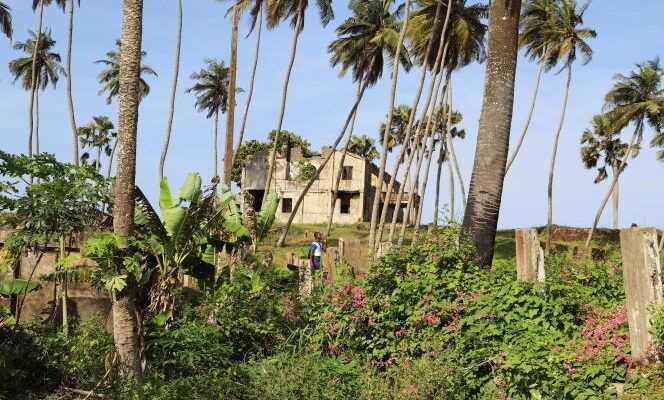Sassandra is like an old postcard taken out of a drawer. Nestled along a grandiose bay, this town in the south-west of Côte d’Ivoire had its finest hours in the 1990s. Since then, the city of more than 70,000 inhabitants, a Mecca for fishing. lobster, withers between its green hills, its river bordered by mangroves and the royal blue ocean.
Guide in town for more than twenty years, Arnaud Gogoua still evokes with nostalgia this time when, barely out of adolescence, he walked dozens of tourists every week. “There were so many people that we recruited amateurs to row on the river”, he recalls. Today, it is barely if he organizes five outings per month.
Like other medium-sized towns, Sassandra suffered from years of political and military crisis triggered on Christmas Eve 1999 by the coup d’état of General Robert Gueï. It was not until twelve years and the end of the violence that opposed Laurent Gbagbo’s supporters to those of the current president, Alassane Ouattara, during the post-electoral crisis of 2011, for the inhabitants of Sassandra to resume hope.
But the region is not part of the State’s priorities: the San Pedro-Sassandra axis may well be a strategic portion of the cocoa loop – of which Côte d’Ivoire is the world’s largest producer – the region is living on. The only notable change is the large modern landing stage offered by Japan, which has revitalized local fishing.
An important heritage
The ocean is certainly full of fish, but it is also out of necessity that Sassandra turns to the Atlantic. On land, the city lives a form of isolation. The State, in charge of the “Coastal”, one of the worst national roads in the country, has long delayed its repair. And the Sassandra-Fresco sections to the east and Sassandra-San Pedro to the west are the worst off on this dangerous and poorly maintained axis which runs 333 km from Abidjan to San Pedro.
In 2019, during a visit to the region, Maurice Bandaman, then Minister of Culture, wanted to dust off the image of Sassandra by comparing it to Algiers or Nice. “If we have the means to build this city with a particular architecture, it will be one of the most wonderful in the world”, he enthused. The minister then pledged to finance the cultural and tourist development of the city to the tune of 20 billion CFA francs (more than 30 million euros). An amount that has still not been released.
Sassandra nevertheless has an important heritage, mixing objects from the slave trade and buildings from the colonial period. Among the best preserved remains the “governor’s palace”, built at the very end of the 19th century.e century, when Côte d’Ivoire became a French colony, and the old black wharf of the 1950s, when the city was the first Ivorian port.
Sylvain Yahi, pastor and planter of Sassandra, hopes that the rehabilitation of the Côtière, which finally began in 2021, will allow tourists to come back and highlight this story. “Passed over in silence”. “People were caught here and then deported, and we don’t even really know how. We learn about the history of other countries, but not our own. We feel like subhumans ”, he confides with a touch of bitterness.
Myths die hard
Sassandra, like the neighboring villages of Drewin and Bassa, was one of the starting points for slaves to Brazil, the United States and the West Indies. The surrounding forest populations were captured for their hardiness and sold to Europeans.
During his visit in 2019, the Minister of Culture wished to continue the West African Slave Route project, the objective of which is to revalue the main sites of the slave trade and to include them on the list of Unesco heritage so that they can be restored and protected. “Build a museum, why not? But what I ask above all is compensation. Our parents donated blood! “, indignant Sylvain Yahi, descendant of an Ivorian family from the land sent by force to the coast.
Near the mouth of the Sassandra river, some ruins are presented as the remains of a prison and a slave market built by Europeans. “This is what we hear over there, but archaeological work must be carried out to verify it”, temper, circumspect, Aka Kouamé, historian specializing in slavery in Ivory Coast. XVIIe at the beginning of the XIXe century, Sassandra was the second point of departure for slaves from the country after Cap-Lahou, renamed Grand-Lahou during colonization. “But there is a priori no construction of this period, he explains. The only vestiges found in certain families are objects linked to trade between the continents. “
In Drewin, too, myths die hard. There, a tunnel is presented to tourists as a place of detention and deportation of slaves located behind the house of Emile Schiffer, a French industrialist at the beginning of the 20th century.e century. “But there is something to be perplexed about, believes Aka Kouamé. The tunnel was too small for men to pass through and there is no reliable source to prove it was used for this. Guides need to be better trained, there are too many stories in this region. “ Developing a city also means accurately retracing its history. So as not to take the wrong path.
Summary of the series “La Côtière, route de tous les galères”
